
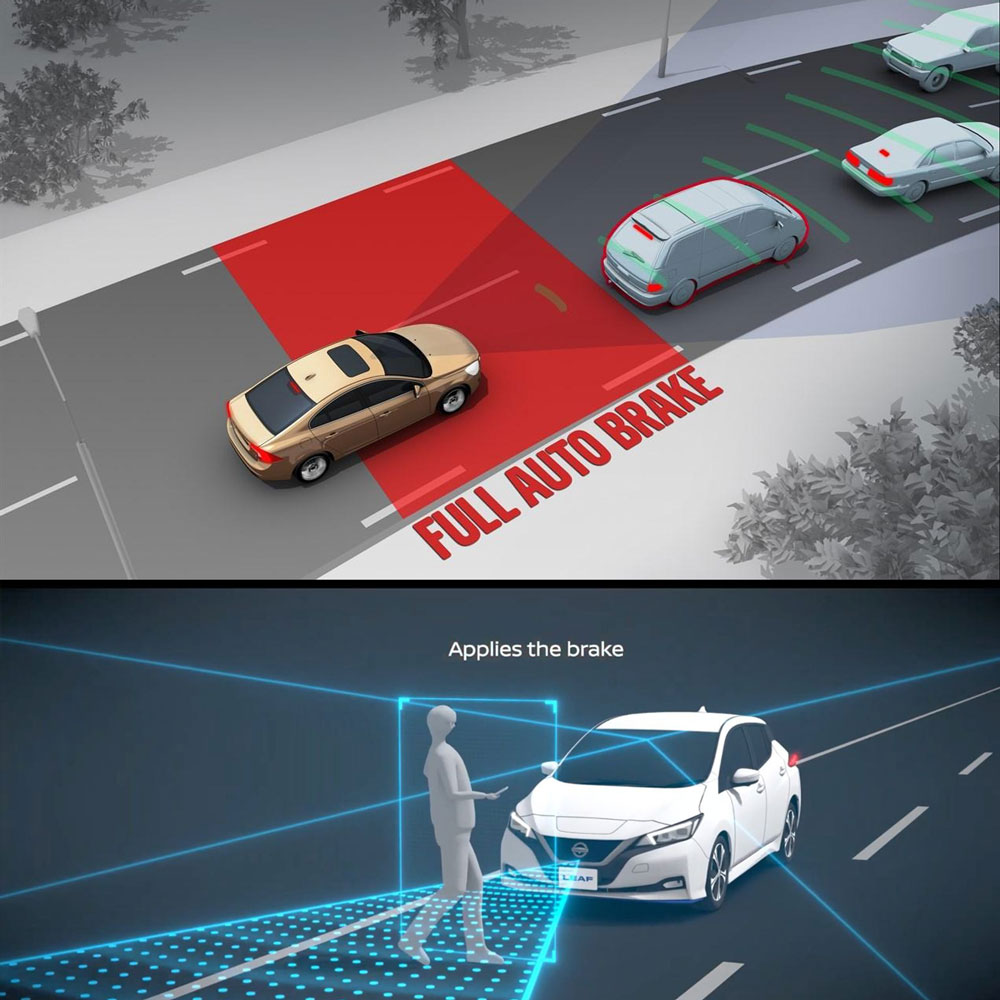
What is Brake Assist System? How It Enhances Your Braking Power
Contents
- 1. Understanding the Brake Assist System
- 2. How Brake Assist Helps You Stop Faster and Safer
- 2.1. Mechanical Brake Assist Systems
- 2.2. Electronic Brake Assist Systems
- 3. How Brake Assist Works with Other Safety Systems
- 3.1. Anti-Lock Braking System (ABS)
- 3.2. Automatic Emergency Braking (AEB)
- 4. How Sensors Enable Smarter Emergency Braking
- 4.1. Dynamic Brake Support (DBS)
- 4.2. Crash Imminent Braking (CIB)
- 5. Brake Assist Regulation and Adoption
- 6. How Brake Assist System Works With ADAS
- 7. What if the Brake Assist System Goes Bad?
- 7.1. Detailed Signs of a Brake Assist Failure
- 7.2. Common Causes of Brake Assist Failure
- 8. Frequently Asked Questions (FAQ) about Brake Assist
- AutoExplain: Your Partner in Automotive Excellence
Have you ever slammed on your brakes, hoping to avoid a collision? AutoExplain understands that in those critical moments, reaction time and braking force are paramount. The Brake Assist System (BAS) is a vital safety feature that maximizes your vehicle’s stopping power in emergency situations, helping to prevent accidents. This guide will explain everything you need to know about brake assist, including its functionality, related systems, and benefits.
1. Understanding the Brake Assist System
The Brake Assist System (BAS), sometimes called the Emergency Brake Assist (EBA), is an integral part of modern vehicle safety. As a component of Advanced Driver Assistance Systems (ADAS), BAS enhances your car’s braking performance when every second counts.
When the system detects a sudden, forceful brake application – a clear sign of an emergency – it instantly applies maximum braking force. This can significantly reduce stopping distance compared to normal braking, potentially avoiding or minimizing the severity of a collision. According to research from the National Highway Traffic Safety Administration (NHTSA), BAS can reduce stopping distances by as much as 45%.
Originally a feature found only in luxury vehicles in the late 1990s, Brake Assist is now standard in most new cars, underscoring its importance in everyday driving safety. Brake Assist systems are particularly helpful in mitigating the risk of rear-end collisions, which account for approximately 30% of all car accidents, according to the Insurance Institute for Highway Safety (IIHS). Other situations where BAS proves invaluable include head-on collisions, merging accidents, intersection crashes, and incidents involving pedestrians or obstacles.
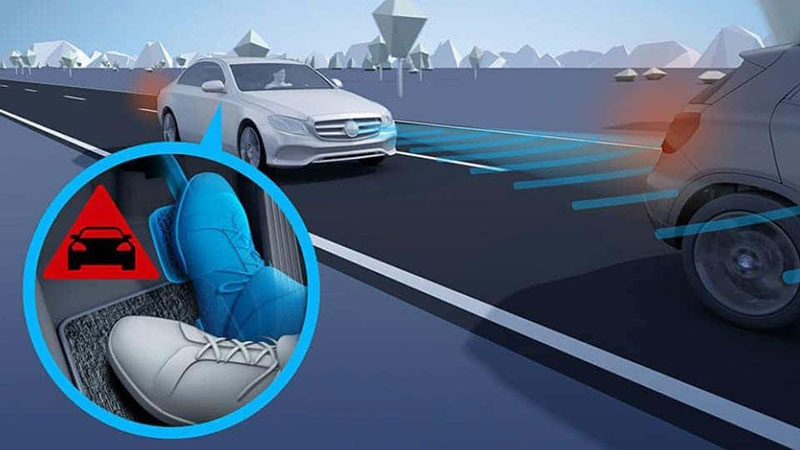
2. How Brake Assist Helps You Stop Faster and Safer
Brake Assist’s primary function is to quickly recognize emergency braking situations and provide additional braking force to reduce stopping distances. How does it achieve this? The system analyzes the driver’s braking behavior, specifically the speed and force applied to the brake pedal, against predefined thresholds.
When a driver applies the brakes rapidly and with significant force, Brake Assist interprets this as an emergency. It then overrides the driver’s input and applies maximum braking power until the Anti-lock Braking System (ABS) activates to prevent the wheels from locking up. According to a study by Daimler-Benz, Brake Assist can reduce stopping distances by up to 45% in emergency situations.
There are two main types of Brake Assist systems:
2.1. Mechanical Brake Assist Systems
Older vehicles typically use mechanical brake assist systems. These systems rely on pre-set thresholds to detect emergency braking based on the driver’s actions. Once the driver’s braking force exceeds these thresholds, the system mechanically transfers braking power from the brake piston valve to the brake booster, enhancing braking effectiveness. Mechanical systems provide a consistent response but do not adapt to individual driving styles.
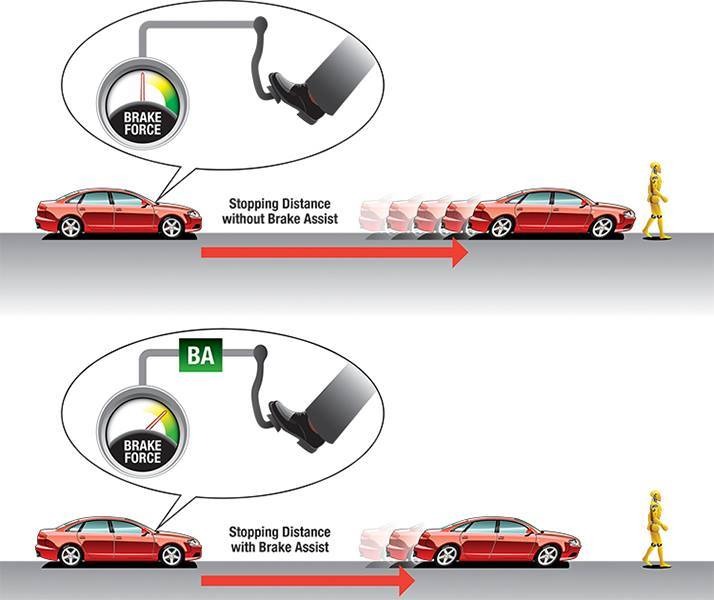
2.2. Electronic Brake Assist Systems
Newer vehicles often feature electronic brake assist systems. These systems use an Electronic Control Unit (ECU) to analyze braking patterns against predefined thresholds. The ECU assesses the driver’s braking behavior and compares it to established benchmarks. When necessary, it deploys emergency braking power. Some advanced systems record information about individual drivers’ braking styles, tailoring the response to their unique habits for enhanced safety and responsiveness.
3. How Brake Assist Works with Other Safety Systems
Brake Assist doesn’t operate in isolation. It works alongside other crucial braking systems to provide comprehensive safety. Here’s how:
3.1. Anti-Lock Braking System (ABS)
Introduced in the late 1970s, Anti-lock Braking Systems (ABS) have become a standard safety feature. ABS prevents wheels from locking during emergency braking. By preventing wheel lock-up, ABS allows drivers to maintain steering control and reduces the risk of skidding. ABS became mandated on all new light vehicles in the US in 2012, alongside Electronic Stability Control (ESC), according to the National Highway Traffic Safety Administration (NHTSA).
In vehicles without ABS, drivers must manually pump the brake pedal to prevent wheel lock-up. ABS automates this process by detecting differences in wheel speed and rapidly pulsing the brakes until all wheels are turning at the same speed. A range of ABS subsystems enhance vehicle safety and control, including:
- Traction Control System (TCS): Reduces wheel slippage during acceleration on slippery surfaces.
- Electronic Differential Lock (EDL): Monitors wheel speeds and applies targeted braking to improve traction.
- Electronic Brakeforce Distribution (EBD): Adjusts braking pressure across individual wheels to maintain stability.
- Electronic Stability Control (ESC): Maintains vehicle stability during sharp turns or emergency maneuvers.
Toyota describes Brake Assist as being “designed to help the driver take full advantage of the benefits of ABS,” indicating that Brake Assist works in conjunction with ABS to optimize braking performance.
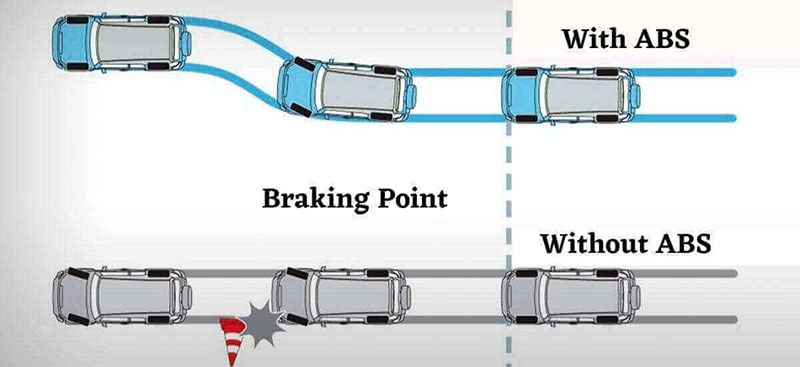
3.2. Automatic Emergency Braking (AEB)
Automatic Emergency Braking (AEB), also known as autonomous emergency braking, is an advanced driver assistance system (ADAS) that automatically applies the brakes based on vehicle speed and distance to an obstruction. AEB does not require the driver’s foot pedal action to initiate braking.
The main difference between AEB and BAS is that AEB applies the brakes automatically, while BAS requires the driver to step on the brakes to be effective. NHTSA believes AEB systems represent the next wave of potentially significant advances in vehicle safety. AEB systems, including Dynamic Brake Support and Crash Imminent Braking, can save lives and reduce rear-end crashes.
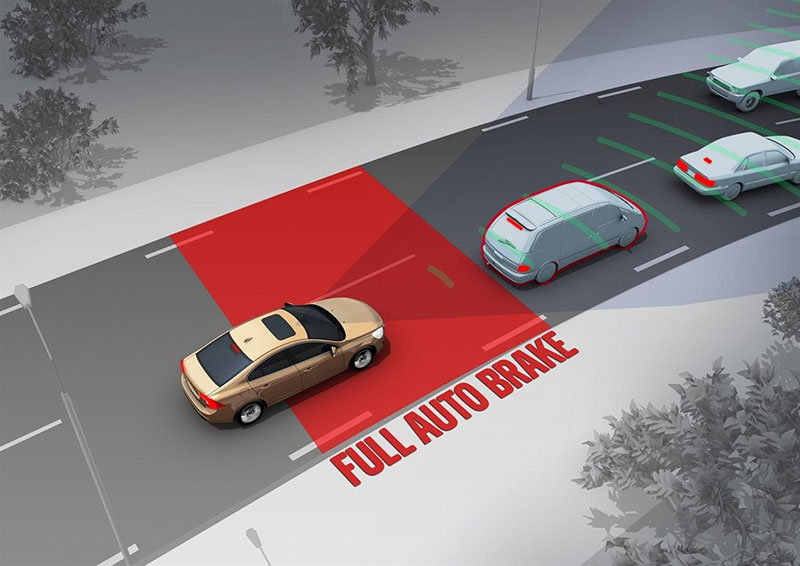
4. How Sensors Enable Smarter Emergency Braking
Modern vehicles are equipped with a range of smart sensors that help them detect obstacles, monitor traffic, and react to potential collisions — often faster than a human driver can. These sensors are the foundation of advanced braking systems like Brake Assist, Dynamic Brake Support (DBS), and Crash Imminent Braking (CIB).
Here’s a quick overview of the key sensors used:
-
Radar – Uses radio waves to measure the distance and speed of objects ahead, even in poor weather or low visibility.
-
Cameras – Capture real-time images to detect vehicles, pedestrians, traffic signs, and road markings.
-
LiDAR – Sends out laser pulses to build a 3D map of the vehicle’s surroundings with high accuracy (mainly used in premium vehicles).
These sensors work together to constantly scan the road. When they detect a sudden obstacle or an imminent risk of collision, they can either support the driver’s braking effort or automatically apply the brakes if the driver doesn’t respond in time.
Two smart braking technologies that rely heavily on sensor data are Dynamic Brake Support (DBS) and Crash Imminent Braking (CIB). Both are part of Automatic Emergency Braking (AEB) systems and are designed to prevent or reduce the impact of a crash.
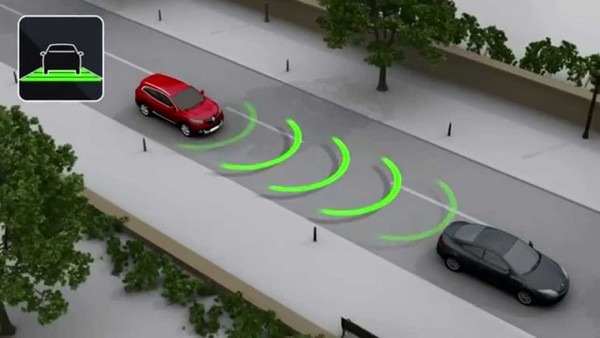
4.1. Dynamic Brake Support (DBS)
If the sensors detect that a crash is likely and the driver starts braking — but not hard enough — DBS will automatically add extra braking power to help avoid or lessen the collision.
Think of it as a more advanced version of Brake Assist, triggered not by how you press the pedal, but by what the sensors “see” ahead.
4.2. Crash Imminent Braking (CIB)
If a collision is about to happen and the driver doesn’t brake at all, CIB will automatically apply the brakes to reduce speed or even stop the car, minimizing the impact.
According to the U.S. National Highway Traffic Safety Administration (NHTSA):
-
DBS could save around 25 lives each year if installed in all U.S. vehicles.
-
CIB has the potential to prevent 200,000 minor injuries, 4,000 serious injuries, and save over 100 lives annually.
These systems show how sensor technology and automation are transforming vehicle safety — making cars more responsive, more intelligent, and ultimately, better at protecting the people inside and around them.
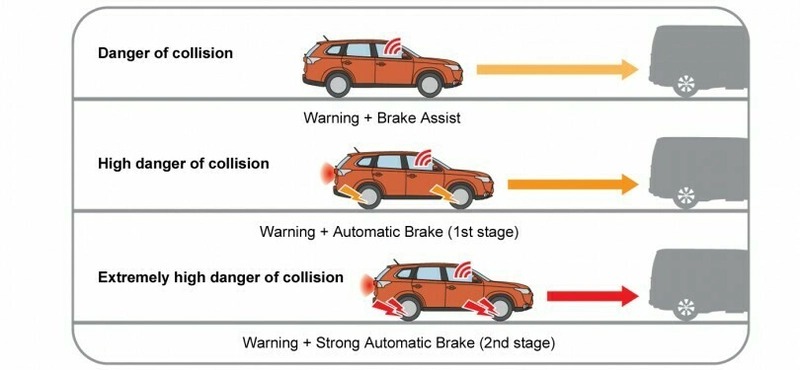
5. Brake Assist Regulation and Adoption
While European lawmakers have mandated BA on all new light vehicles, US officials have focused more on regulating automated braking (AEB). In the U.S., twenty automakers pledged voluntarily to make AEB with forward collision warning (FCW) standard on light-duty vehicles by September 2022. As of now, several automakers have already met this commitment ahead of schedule, including Audi, BMW, Hyundai, Mazda, Mercedes, Subaru, Tesla, Toyota, Volvo, and VW.
6. How Brake Assist System Works With ADAS
Brake Assist is often part of a comprehensive suite of safety features working in sequence to help you avoid crashes. The forward collision sequence illustrates how these systems work together.
- Forward Collision Warning (FCW): Sensors calculate a crash risk and warn you.
- Brake Assist (BA) or Dynamic Brake Support (DBS): Your foot on the brake initiates traditional BAS, or DBS automatically provides additional braking force.
- Automatic Emergency Braking (AEB): If the driver fails to act, AEB automatically applies the brakes (CIB).
This sequence ensures maximum driver control until the last possible moment while providing layers of automated assistance to prevent or mitigate collisions.
7. What if the Brake Assist System Goes Bad?
When the brake assist system (BAS) malfunctions, your vehicle may lose its ability to automatically increase braking force during emergency stops. While the base hydraulic brake system usually remains functional, the loss of brake assist can increase stopping distances and reduce the effectiveness of panic braking, especially when milliseconds matter.
7.1. Detailed Signs of a Brake Assist Failure
7.1.1. Dashboard Warning Messages
Messages such as “Brake Assist Unavailable,” “Service Brake System,” or ABS/ESC indicator lights may illuminate.
Some vehicles may display “Pre-Collision System Malfunction” if BAS is tied to ADAS features like Automatic Emergency Braking (AEB).
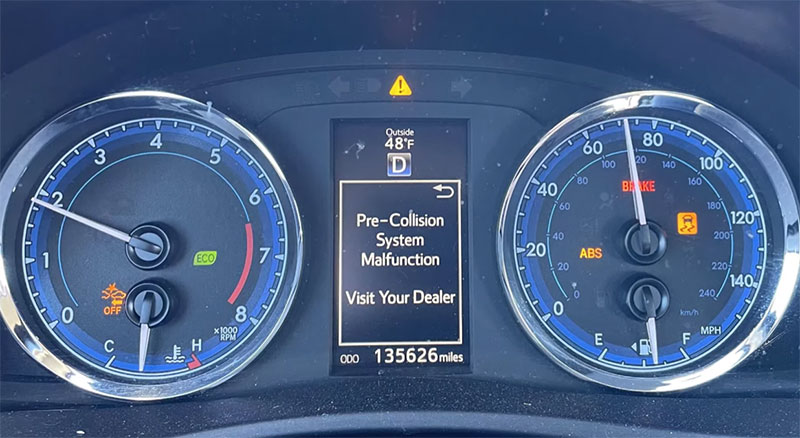
=> Related content:
- Tips to Clear ABS and ESP Inoperative Warning in Your Mercedes Benz
- How to Fix ‘Active Brake Assist Functions Limited’ on Mercedes
- How to Fix ‘Active Brake Assist Not Available’ Warning on Your Mercedes
7.1.2. Increased Pedal Effort in Emergencies
Drivers may notice that the brake pedal feels harder to press during a sudden stop.
This is especially dangerous if the driver cannot apply sufficient force in time to trigger full braking power.
7.1.3. Reduced Brake Boost
In vehicles using mechanical brake assist, a faulty brake booster (vacuum or hydraulic) may cause the pedal to feel unusually firm.
In electronic systems, the ECU may fail to engage the assist function, especially if input from the brake pedal sensor is inconsistent.
7.1.4. Brake Assist Not Engaging
Even if brakes are applied quickly and forcefully, the system may not recognize it as an emergency, due to:
A failed brake pressure sensor
A miscalibrated or non-functional brake pedal travel sensor
Faulty or uncalibrated ADAS sensors (in systems integrated with AEB or forward collision mitigation)
7.1.5. Stored Fault Codes (DTCs)
- Using a scan tool, you may find codes like:
7.1.5.1. BMW Brake Assist / DSC-Related Error Codes
*Diagnostic Tools:
- BMW ISTA+
- Foxwell NT510 Elite / NT530 BMW Scanner
- Autel MaxiSys MS906 / MS909 / MS Ultra
| Code | Description | Likely Cause |
|---|---|---|
| 5E20 | Pressure sensor 1 faulty | Faulty brake pressure sensor |
| 5E24 | Brake pressure sensor 2 error | Sensor failure or wiring issue |
| 5DF0 / 5DF1 | Hydraulic unit pump motor / control module failure | Internal DSC module issue |
| 5E1A | Brake Assist function deactivated | Due to sensor or module fault |
| 5E19 | Brake Light Switch Fault | Impacts Brake Assist trigger |
| 4809BD | DSC control unit: Internal fault | Could deactivate Brake Assist |
7.1.5.2. Mercedes-Benz BAS / ESP Fault Codes
*Diagnostic Tools:
- Mercedes Xentry / DAS (Official Tool)
- Autel MaxiSys MS906 / MS908 / MS909 / Ultra
- iCarsoft MB V3.0 or MB II
- ThinkDiag / Launch X431 Series
=> Download Mercedes Xentry Software
=> Best Code Reader for Mercedes Vehicle
| Code | Description | Likely Cause |
|---|---|---|
| C1401 | BAS/ESP hydraulic unit internal fault | May require module replacement |
| C1024 | Brake Pressure Sensor 1 faulty | Sensor or wiring issue |
| C1026 | Brake Pressure Sensor 2 faulty | Sensor or signal malfunction |
| C249F | Yaw Rate Sensor fault | Affects ESP and Brake Assist |
| C1014 | Brake Light Switch fault | Prevents BAS activation |
| C1353 | BAS not available – CAN communication error | CAN bus or control unit fault |
| C2560 | Vacuum supply of brake booster faulty | Weak Brake Assist power |
Click here to read some tips to fix the Mercedes brake assist error code:
BAS errors are often tied into the ESP (Electronic Stability Program) or SBC (Sensotronic Brake Control) system in older models.
7.1.5.3. Audi / VW Brake Assist / ESC-Related Codes
| Code | Description | Likely Cause |
|---|---|---|
| 01435 | Brake Pressure Sensor 1 (G201) – Implausible signal | Sensor failure or voltage issue |
| 01314 | Engine Control Module (ECM) – No communication | BAS/ESC deactivation |
| 01276 | ABS Hydraulic Pump (V64) – Mechanical failure | Affects Brake Assist delivery |
| 18265 / P1857 | Load Signal error from ECU | Affects torque/brake coordination |
| 00003 / 01316 | Control module for Brake Electronics – Faulty or no communication | BAS might not function |
| 01423 | Lateral Acceleration Sensor (G200) | May impair ESC & Brake Assist |
Click here to read some tips to fix the Audi brake assist error code:
7.2. Common Causes of Brake Assist Failure
The Brake Assist System (BAS) relies on a combination of mechanical components, sensors, and electronic control units. A failure in any one of these areas can prevent the system from detecting emergencies or providing the necessary additional braking force.
7.2.1. Brake Pedal Position Sensor (or Brake Light Switch)
-
Function: Monitors how quickly and how far the brake pedal is pressed — a critical input for detecting emergency braking behavior.
-
Failure symptoms:
-
Brake Assist does not activate even during sudden braking.
-
In some cars, brake lights may flicker or fail to illuminate.
-
-
Common causes:
-
Wear and tear of the switch mechanism.
-
Misalignment after brake pedal or master cylinder service.
-
Electrical short or corroded wiring harness.
-
7.2.2. Brake Pressure Sensor
-
Function: Measures hydraulic pressure in the brake lines to determine if an emergency braking event is occurring.
-
Failure symptoms:
-
Inaccurate pressure readings leading to failure in triggering assist.
-
Stored DTCs such as C1350, C1A13, or manufacturer-specific codes.
-
-
Common causes:
-
Contaminated or old brake fluid causing sensor fouling.
-
Internal sensor failure due to age or fluid leaks.
-
Damaged connector or wiring from heat or moisture.
-
7.2.3. Brake Booster (Vacuum or Hydraulic)
-
Function: Multiplies the force applied by the driver to the brake pedal.
-
Failure symptoms:
-
Hard or unresponsive brake pedal.
-
Whistling noise from the brake booster area (indicating vacuum leak).
-
Increased stopping distance in emergency situations.
-
-
Common causes:
-
Vacuum leaks in hoses or check valve.
-
Faulty vacuum pump (common in turbocharged or diesel engines).
-
Internal diaphragm failure in the booster unit.
-
7.2.4. ABS Control Module
-
Function: Works in conjunction with BAS to modulate brake pressure and prevent wheel lock-up during emergency stops.
-
Failure symptoms:
-
ABS and BAS warning lights both illuminated.
-
Brake Assist fails to engage or pulses erratically.
-
-
Common causes:
-
Water intrusion in the ABS module.
-
Software corruption or failed firmware update.
-
Wheel speed sensor data mismatch (often misinterpreted as ABS or BAS fault).
-
7.2.5. Electronic Control Unit (ECU) for Brake Assist / ESC Module
-
Function: Analyzes sensor input and decides when to apply additional braking force.
-
Failure symptoms:
-
Intermittent or no activation of Brake Assist during tests.
-
Vehicle may default to limp braking mode.
-
-
Common causes:
-
Power supply issues or ground fault.
-
Internal processor failure or short circuit.
-
Faulty firmware or communication errors with other modules (e.g., CAN bus).
-
7.2.6. ADAS Sensors (Radar, Camera, LiDAR) — For AEB-Integrated Brake Assist
-
Function: Detect objects ahead and assess collision risk to trigger automatic or assisted braking.
-
Failure symptoms:
-
Messages like “Pre-Collision System Malfunction” or “Brake Assist Unavailable.”
-
Brake Assist and AEB may both be disabled.
-
-
Common causes:
-
Sensor misalignment after a collision or windshield replacement.
-
Dirt, snow, or obstruction blocking sensor view.
-
Improper ADAS calibration after service work.
-
7.2.7. Battery or Power Supply Problems
-
Function: Supplies stable voltage to ECU, sensors, and actuators.
-
Failure symptoms:
-
Random or intermittent Brake Assist activation failure.
-
Flickering warning lights or complete module shutdown.
-
-
Common causes:
-
Weak battery or failing alternator.
-
Poor ground connection or corroded terminals.
-
Voltage spikes damaging control modules.
-
7.2.8. Software/Programming Errors
-
Function: Controls logic flow for Brake Assist activation.
-
Failure symptoms:
-
Brake Assist activates when it shouldn’t, or fails to activate when it should.
-
Ghost DTCs (diagnostic codes with no physical failure).
-
-
Common causes:
-
Improper module coding after replacement.
-
Software updates not performed or incorrectly installed.
-
Mismatched firmware across control modules.
-
8. Frequently Asked Questions (FAQ) about Brake Assist
8.1. What is Brake Assist in vehicles?
Brake Assist is a safety system that applies maximum brake force during a driver’s panic or emergency braking, significantly reducing braking distance.
8.2. How does Brake Assist work?
Brake Assist monitors the speed and force with which a driver presses the brake pedal. If it detects a panic braking situation, it applies the brakes at full strength until the anti-lock braking system (ABS) takes over.
8.3. What is the difference between Brake Assist and ABS (Anti-lock Braking System)?
Brake Assist helps apply maximum braking force in emergencies, while ABS prevents the wheels from locking up during braking, helping maintain vehicle control.
8.4. What is Automatic Emergency Braking (AEB)?
AEB is an advanced system that automatically applies the brakes based on vehicle speed and distance to an obstruction, without requiring the driver’s foot pedal action.
8.5. How can I tell if my car has Brake Assist?
Check your vehicle’s owner’s manual or consult with a qualified mechanic. Most modern vehicles come standard with Brake Assist, but it’s best to confirm.
8.6. Does Brake Assist require maintenance?
Brake Assist systems are generally maintenance-free. However, regular brake system inspections are essential to ensure all components are functioning correctly.
8.7. Can Brake Assist be disabled?
Brake Assist is a critical safety feature and cannot be disabled.
8.8. How does Brake Assist affect my insurance?
Vehicles equipped with advanced safety features like Brake Assist may qualify for insurance discounts. Check with your insurance provider for details.
8.9. What should I do if my Brake Assist system malfunctions?
If you suspect a problem with your Brake Assist system, have it inspected by a qualified mechanic as soon as possible.
8.10. Are there any driving techniques that can maximize the effectiveness of Brake Assist?
In an emergency, apply firm, steady pressure to the brake pedal. The Brake Assist system will automatically provide additional braking force if needed.
AutoExplain: Your Partner in Automotive Excellence
At AutoExplain, we understand the complexities of modern automotive technology. That’s why we offer cutting-edge coding and programming solutions to empower auto repair shops and technicians. By partnering with us, you can:
- Stay Ahead of the Curve: Access the latest coding and programming techniques to service advanced vehicle systems.
- Expand Your Service Offerings: Offer advanced services like ADAS calibration, ECU programming, and more.
- Increase Efficiency: Streamline your workflow with our user-friendly tools and expert support.
Ready to transform your auto repair shop?
- Contact AutoExplain today at 1500 N Grant ST Sten Denver, Colorado, United States
- Whatsapp: +1(936)2896695
- Email: [email protected]
Visit our website at autoexplain.com to discover how we can help you thrive in the evolving automotive landscape.

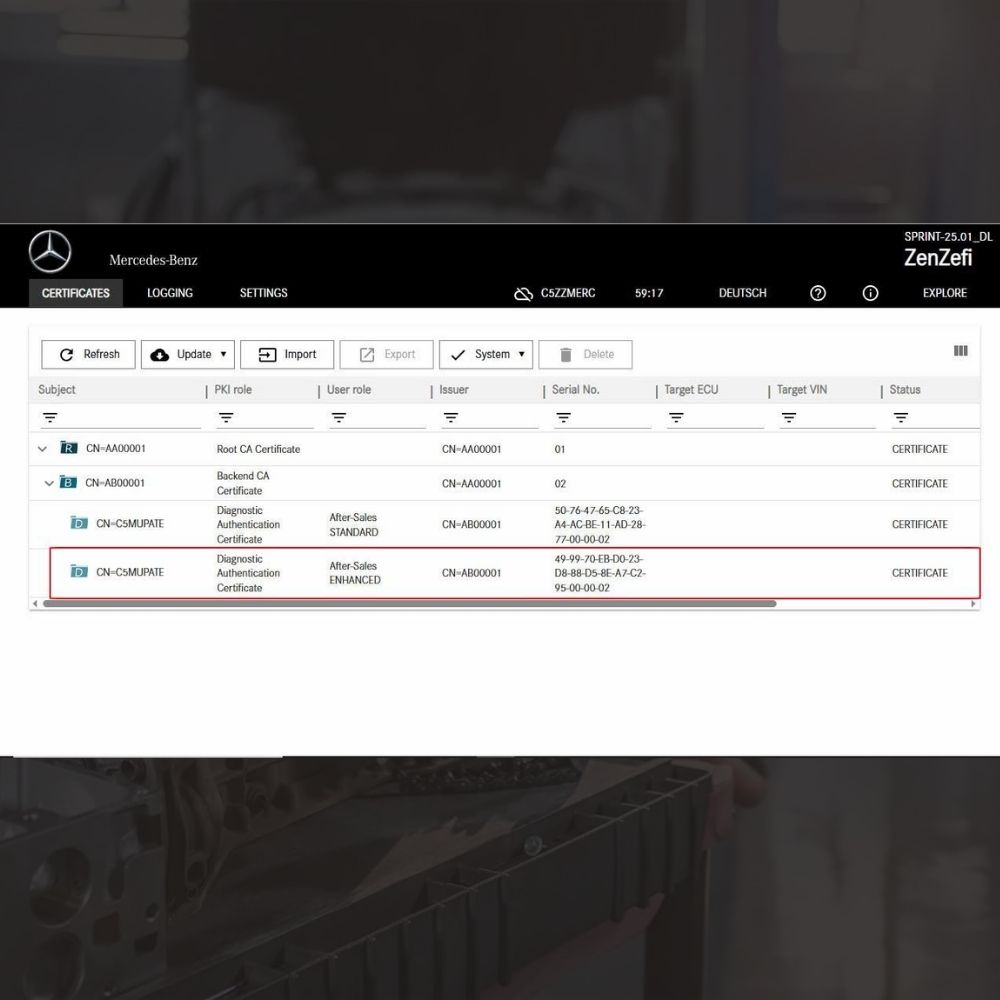
New Mercedes Car Coding Solution with ZenZefi certificate for DTS Monaco 9.02

What is DTS Monaco? Key Functions of DTS Monaco Software
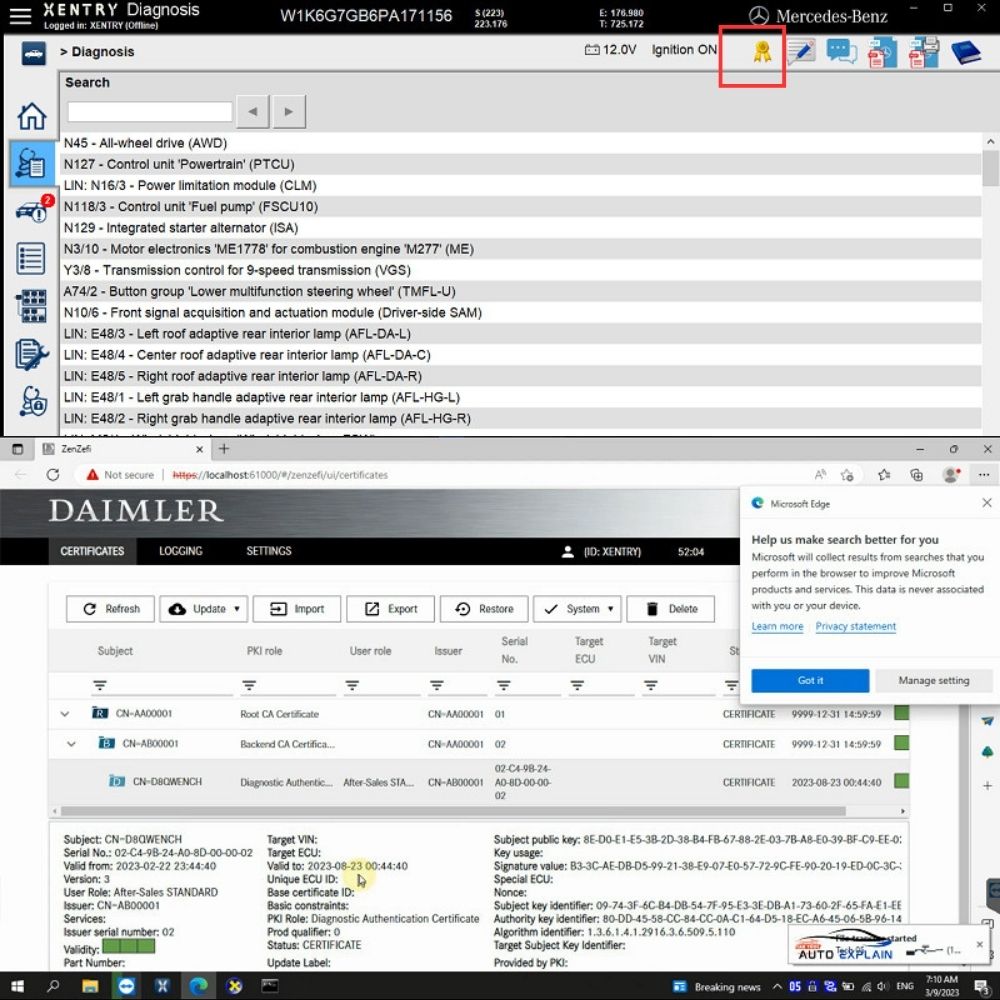
What is the Xentry Certificate Zenzefi? Why You Need It, and When It Is Required?



New Mercedes Car Coding Solution with ZenZefi certificate for DTS Monaco 9.02





